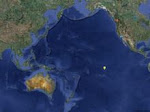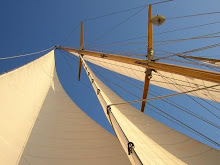Atuona is a small town located on the southern end of Hiva Oa in the southern chain of the Marquesas Islands. The population is a mixture of Polynesians from all over the Pacific Islands and Caucasians, primarily from France. The town has a post office, one bank (that I know of), four grocery stores, a general store, and a hardware store. Fresh crusty baguettes are available in nearly every store for 64 francs (less than a dollar). Fresh eggs are also readily available in the stores and from nearby farm trucks which also sell local produce and fresh-caught tuna. These eggs are not cheap (450-500 francs / dozen), but considering the number of chickens we've seen running around town and through the hills, the eggs must be the best free-range eggs we've ever had!
We arrived last week on a day with large swell, periodic rain showers, and brilliant rainbows arching neatly over the tall green cliffs of Hiva Oa. We thought we would be the last boat to arrive this year because no other boats had joined the radio net (Pacific Puddle Jump) after us. We were, I think, possibly the last boat to leave the west coast of North America headed for the Marquesas Islands because the northern hemisphere hurricane season was just starting to be active around that time. We had heard some pretty dire weather predictions for anyone leaving Mexico around the time we reached the doldrums, and I think those predictions pretty well cut off some peoples' cruising plans for the year. But, now that we've been in port for a few days, we realize that we were far from being the last to arrive. More boats arrive every day, but these boats have made passage from the Atlantic Ocean, through the Panama Canal, and had stopped at the Galapagos Islands on their way to the Marquesas.
One of these boats was skippered by a 14-year old girl from the Netherlands, who I must say has her head screwed on straighter than most Americans in their mid-twenties. She arrived within an hour of us on her shiny red boat "Guppy" and proceeded to haul a black-and-white pirate flag up the mast, with raucous applause from the rest of the anchorage. Everyone seemed to know each other already… and they did, because they all met in the Galapagos.
As we approached the small bay, we were hailed on the VHF radio by one of the boats that we had talked to often on the radio net – a single-hander on a 30-foot boat, "Murre," named for the diving sea bird commonly seen in the north Pacific. We had never met in person before, and we were shocked that he so quickly recognized Columbine before we even entered the harbor. I guess the varnished wooden masts were a dead give-away. He was pleased to see someone he "knew," and graciously offered to help us set our stern anchor. This was an incredible help since we had never really tried anchoring both our bow and stern anchors before. It would have been a bit trickier without someone in the dinghy to row the stern anchor away.
Now, most of the boats that were here when we arrived have left for other ports and anchorages. We stayed on here a bit longer than we'd like to because we were waiting for a replacement autopilot to arrive. Thanks to the Tahiti Yacht Agency, whom we hired to help us with the paperwork in our first foreign country, the package arrived just a couple of days ago. Glenn is outside right now working out how to install this new autopilot, which is much more robust than the one we had previously, but also requires a different configuration. Once we have that hooked up, we will be ready to pull up our anchors, and explore more of the Marquesas Islands.
Where are we going next? Well, we haven't quite figured that out yet. It seems most cruisers operate on a similar level of lack of planning. The problem is that there are just so many islands to visit. Each one offers very different sights, experiences, and levels of interactions with the locals. Sometimes, it is nice to find a
secluded spot to just be on your own. On the other hand, interacting with the locals is fun, challenging (if you don't speak each other's languages well), and always educational. The best way that I have found to meet the locals is to accept a ride either to or from town. It is just a short ride (a couple of miles), the perfect amount of time to ask a few questions and to learn about each other. I have met a social worker (child-protective services) from France, who walks around each of the Marquesas Islands, visiting families in some very remote villages. One woman from Belgium originally has lived on Hiva Oa with her husband for 30 years because they were tired of their modern lifestyle in Europe. They are both artists – she hand-makes tapa cloths and he paints images on the cloths. She showed me a sample of their work and it is as fine as any Japanese painting I have seen. Another woman I met was originally from Tahiti. As she spoke of her past, I got the impression that she must be over 60 years old, but she did not look more than 40 years old to me. It seems that life on the islands is quite good for some people. She taught me how to say thank you in Tahitian and in Marquesan. They are quite different (and I don't know how to spell either).
Mao Ruru (Tahiti)
Vai Ei Nui (Marquesas)
Thursday, June 2, 2011
Subscribe to:
Posts (Atom)


